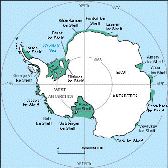Antarctic Drilling Program (ANDRILL)

ANDRILL Related Publications of Affiliates
Document Type
Article
Date of this Version
2007
Abstract
Data from cores collected from sites that were beneath the Ross Ice Shelf until 2000 and 2002 indicate that sub-ice shelf lithofacies are distinguishable from sub-glacial and glacial marine facies. Glacial marine sediment is characterized by diatom-rich, low-density, olive-green, sandy-muds, whereas sub-ice shelf sediment is defined by a lack of diatoms and muds that are enriched in silt and fine sand. Sub-glacial sediment is composed of diatom-poor, high density, coarse grained sandy-mud, rich in fine to coarse sized pebbles. Repetitive, fining-up packages, composed of fine-sand/silty-mud (distal sub ice-shelf deposits), grading into coarse pebbly-mud (sub ice-shelf proximal to the grounding line), suggest cyclicity in the movement of the grounding line over the last 11,000 yrs in the eastern Ross Sea. This research may facilitate a new understanding of ice-shelf dynamics, and possibly refine the current models for the Ross Ice Shelf’s recent glacial history.


Comments
Citation: Boyd, L.S., L.R. Bartek, B. Luyendyk, and D. Wilson (2007), Contrasting sub-ice shelf, sub glacial and glacial marine deposition: Implications for ice shelf stability, in Antarctica: A Keystone in a Changing World – Online Proceedings of the 10th ISAES X, edited by A.K. Cooper and C.R. Raymond et al., USGS Open-File Report 2007-1047, Extended Abstract 152, 6 p.